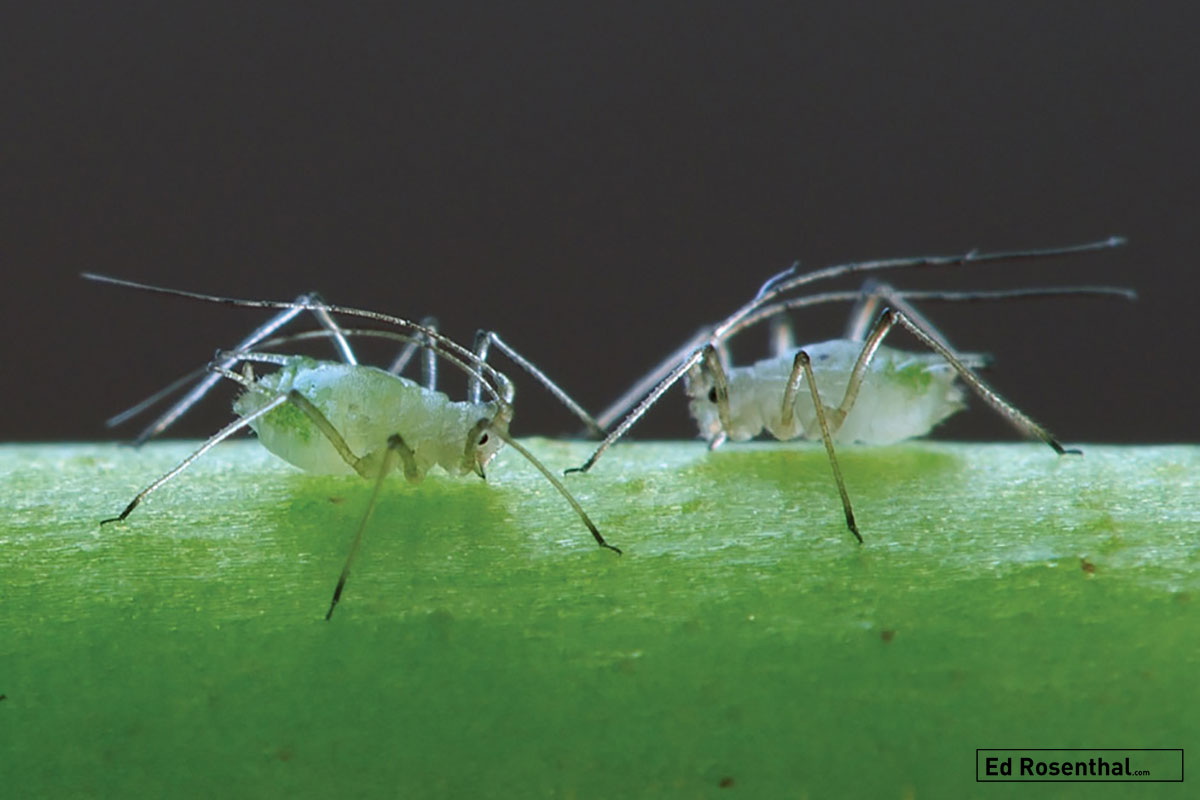13 Ways to Organically Prevent and Control Aphids
Aphididae Puceron "Aphid" - Photo by Luc Viatour
Aphids are a common indoor pest. They attack plants outdoors in warm weather.
Aphids are small pear-shaped soft-bodied insects about 1-3 mm long. There are thousands of species that vary in color from green to yellow, black or brown. Depending on the species and the stage of life the aphid is in, it may have wings, wax or “wool” made from webbing they secrete, or other unique features.
A common trait of aphids which distinguishes them from all other insects is the pair of tailpipe-like cornicles which extend from their abdomen.
Aphids colonize the stems and undersides of plant leaves. Some species, such as the black bean aphid, are quite noticeable because their color stands out from the plant. Others, such as the green peach orchid, are often colored spring green and blend in with young leaves.
Aphids puncture stems, branches and leaves and suck sap from them using a straw-like mouth, called a cornicle. To obtain enough protein, aphids suck a lot of juice, refine the protein and excrete the concentrated sugar solution referred to as “honeydew,” which attracts ants that herd the suckers, protecting them from predators. Honeydew is a growth medium for sooty fungus, which causes necrosis of plant tissue.
Heavy aphid infestations cause leaf curl, wilt, stunted and delayed growth.
Aphids are vectors for hundreds of diseases and can quickly cause an epidemic. They transfer viruses, bacteria and fungi from plant to plant.
During warm weather each generation takes only 7 to 14 days, and each aphid can produce as many as 100 young, depending on the species. This high reproduction rate lets aphids seem to appear overnight. Indoors, with no predators to keep them in check, they can overrun a garden very quickly.
PREVENTION
Aphids on a plant
1. Air Filtration: Aphids are airborne for part of their life cycle, so a fine dust filter in the air intake prevents aphid entry.
2. Monitoring: Check the plants regularly for aphids—at least twice weekly when plants are growing rapidly. Most species of aphids cause the greatest damage when temperatures are warm but not hot (65° to 80° F) (18° to 26° C). They are most prevalent along the upwind edge of the garden, close to outside sources of aphids; check leaf undersides, where many species hang out.
3. Check for ants: when they are present aphids are much more difficult to control, so they must also be eliminated.
4. Catch infestations early. Once their numbers are high and they have begun to distort and curl leaves, aphids are hard to control because the curled leaves shelter them from insecticides or natural enemies.
Outdoors, aphids are usually not a problem because of natural enemies such as lady beetles, lacewings and syrphid fly larvae.
CONTROL
Outdoors, ladybugs are natural enemies of aphids - Photo by TCurtiss
Outdoors: Sometimes aphids must be controlled outdoors. This is often accomplished by spraying them off with water. If they remain a problem consider one of the controls listed in the indoor section.
Indoors: Aphids have an easy life indoors and in the greenhouse. They are not threatened by weather, and predators. Without nature's calamities, aphid populations grow exponentially.
5. Aphid Parasites and Predators:
Parasites are most effective before an outbreak has reached epic proportions. Predators are recommended for heavy infestations. However, this may just be a prejudice caused by the subtlety of para-sites as compared to the aggressive moves of the predators. Predators spend a portion of their life eating and killing aphids and close-up their actions can be as vicious and dramatic as an alligator’s. Parasites inject eggs into aphid larvae. The egg hatches and the parasite larvae feasts inside. It emerges as an adult, “Alien” style, from the mummy. Not quite as dramatic as rampaging predators, except when the newborns crawl out of the corpse, but every bit as effective.
6. Two species of parasitic wasps, (Aphidius matricariae and Aphidius ervi) lay their eggs inside aphid larvae. The parasitized larvae turns brown or black, referred to as a mummy. The generation time of most parasites is quite short when the weather is warm. Once mummies appear on the plants, the aphid population is likely to be reduced substantially within a week or two.
7. Aphidoletes aphidimyza, which are available commercially, are predatory gall midges, that are effective indoors and in greenhouses. They are delicate looking black flies, less than 1⁄8” (3 mm) long, that live for an average of 10 days, feeding on aphid honeydew. They hide beneath leaves during the day and are active at night when the female deposits her eggs in aphid colonies. In two or three days, tiny, bright-orange larvae emerge and begin feeding on the pests for two weeks. Then they pupate in the ground and an adult gall midge emerges 7 to 14 days later. For this reason they cannot be used in conjunction with beneficial nematodes, which eat the pupae.
8. Beauveria bassiana is a beneficial fungus fatal to many insects including aphids.
9. Essential oils derived from plants can be used as safe alternatives for pest control. Certain plants developed their own defense mechanisms: some destroy the exoskeleton while others deteriorate the nervous systems of pests. There are several brands available including Ed Rosenthal’s Zero Tolerance™ which has a wide spectrum of essential oils that work to deter pests and diseases.
10. Herbal teas that include capsaicin, cinnamon oil, cloves, coriander oil, garlic and Italian seasoning are also effective. Mix 1 tablespoon spices per quart of water. If the plant has necrosis from the strength, dilute it. The herbs can be mixed to make your own concoction.
11. Insecticidal soap sprays coat and smother aphids.
12. Neem oil smothers insects but leaves an oily residue.
13. Pyrethrum is a natural plant based pesticide that is widely available.
Join our cannabis community
Follow Us









